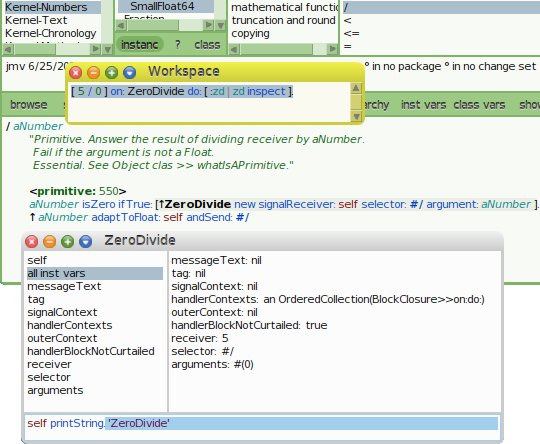10.1 Inspecting the Unexpected ¶
We have seen how various exceptional situations cause the appearance of
a debugger window. Indeed, Exceptions are also
objects which remember their context and can present it. Above, we have
seen how to generate MessageNotUnderstood and ZeroDivide
Exception instances.
This is another area where the actual mechanics are complex, but the basic ideas are simple.
Exception instances, being objects, also have classes. The BlockClosure
has a method category exceptions which gathers some handy methods
which allow one to ensure: cleanup or capture and use exceptions
(on:do: and friends).
FileEntry>>readStreamDo: blockWithArg "Raise FileDoesNotExistException if not found." | stream result | stream := self readStream. [ result := blockWithArg value: stream ] ensure: [ stream ifNotNil: [ :s | s close ]]. ^ result
Example 10.1: Ensure a FileStream is closed
Exceptions are created and signaled. Let’s make one and look at it.

Figure 10.1: Inspecting a ZeroDivide instance
Again, we can use an Inspector on any object, and Exceptions are
no exception! Now you know how to capture one when you need to.
Exceptions, like MorphicEvents are a change,
an exception, to typical control flow.
We noted above the special
pseudo-variable, thisContext. Signalling an exception
captures this.
Exception>>signal ^ self signalIn: thisContext
Example 10.2: Capture thisContext
Just as Smalltalk code has special view windows which we call Browsers,
Exceptions have an enhanced viewer we call the Debugger.
Let us look at how to use this very useful viewer.